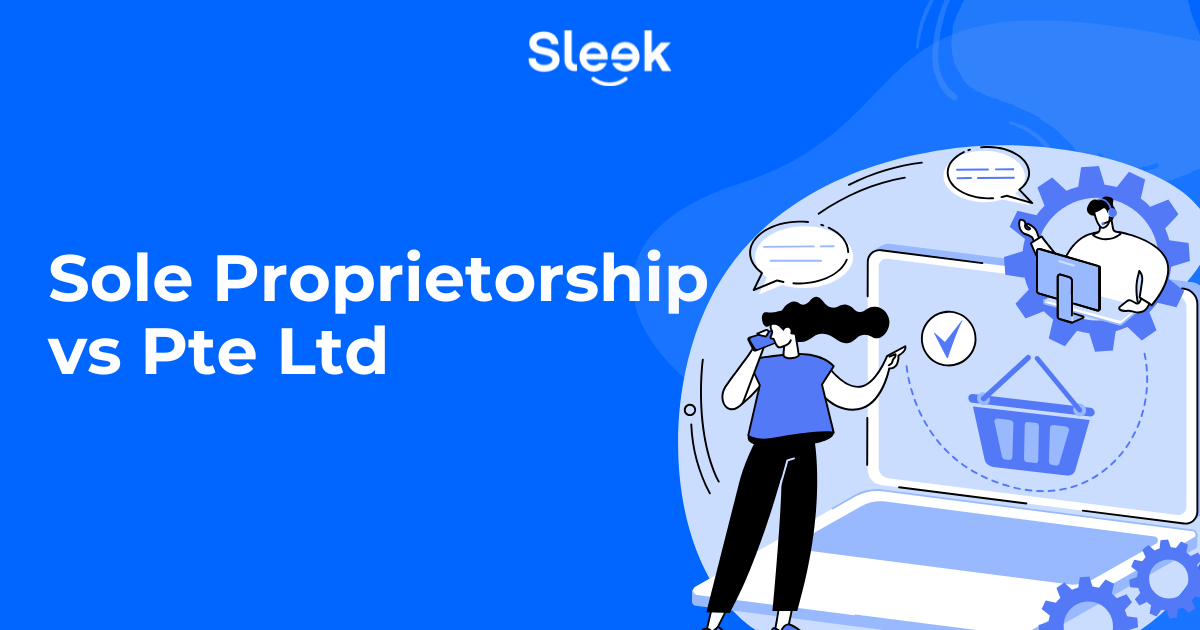“Sole proprietorship vs Pte Ltd” might sound like just a formality, but getting it wrong can cost you in taxes, liability, or missed opportunities. If you’re starting a business in Singapore, this is one of the most important choices you’ll make. One setup is fast and cheap. The other offers protection and long-term growth. You just want to get it right without second-guessing later.
This guide will help you choose wisely before it’s too late to switch.
Sole Proprietorship vs Pte Ltd: Quick overview
A sole proprietorship in Singapore is owned and operated by one person and is not legally separate from its owner. In contrast, a Private Limited Company (Pte Ltd) is a separate legal entity, owned by shareholders, offering limited liability and better access to tax benefits, funding, and long-term growth opportunities.
What is a sole proprietorship?
A sole proprietorship is the simplest business structure in Singapore. It’s owned by one person, with no legal separation between you and the business, meaning you’re personally liable for all debts and obligations.
It’s fast to set up, low-cost, and easy to run, making it a common choice for freelancers and solo entrepreneurs. But there’s no legal protection, and your personal assets are exposed if things go wrong.
In short, it’s:
- Owned by one person
- Not a separate legal entity
- Full personal liability
- Income taxed as personal earnings
- Locals or approved pass holders eligible
- Foreigners need local rep and MOM approval
Note: If you’re self-employed, you’ll need to top up your CPF Medisave account before registering or renewing your sole proprietorship.
What is a private limited company (Pte Ltd)?
A Private Limited Company (Pte Ltd) is a registered business that exists as a separate legal entity from its owners. It’s owned by shareholders and managed by directors, which means your personal assets are protected if the company runs into debt or legal issues.
This structure is ideal for businesses that want to scale, attract investors, or access tax incentives. While it involves more setup and compliance, the long-term benefits often outweigh the extra effort.
In short, it’s:
- Separate legal entity from its owners
- Limited liability for shareholders
- Profits taxed at corporate rates
- Can be owned by locals or foreigners
- Requires at least one local resident director and a company secretary
Difference between sole proprietorship and private limited company
Use this side-by-side breakdown to understand how each structure works in Singapore and which suits your business best.
Category | Sole Proprietorship | Private Limited Company (Pte Ltd) |
Legal Structure | The owner and the business are legally the same | A separate legal entity from its shareholders |
Liability | The owner is personally liable for all debts and obligations | Shareholders are not personally liable beyond their investment |
Ownership | Owned and operated by one individual | Owned by shareholders and managed by directors |
Capital | Limited to the owner’s personal funds and business profits | Can raise capital by issuing shares to investors |
Bankruptcy Restrictions | Undischarged bankrupts cannot manage a sole proprietorship without Court or Official Assignee approval | Undischarged bankrupts cannot be directors or manage a company without Court or Official Assignee approval |
Business Succession | Ends when the owner retires or passes away | Continues even if ownership changes |
Decision Making | The owner makes all business decisions | Directors manage the company while shareholders vote on major matters |
Taxation | Profits are taxed as personal income | Profits are taxed at the corporate tax rate with exemptions for new companies |
Compliance | Minimal requirements with few filings | Requires annual filings, meetings, and director disclosures |
Public Perception | Viewed as less formal and less stable | Considered more credible and investor-friendly |
Risk | Higher personal risk due to unlimited liability | Lower personal risk due to limited liability |
Transfer of Ownership | Hard to transfer — typically involves selling business assets | Ownership can be transferred by selling or assigning shares |
Ease of Setting Up | Simple and fast to register | Requires incorporation documents and appointments |
Ease of Closing | Easy to terminate with minimal steps | More formal process with legal and regulatory requirements |
Best For | Freelancers, solo operators, and low-risk businesses | Companies planning to grow, raise capital, or scale professionally |
Need a quick reference? Download this comparison table as an image for easy viewing and sharing.

Private Limited vs Limited Liability Partnership (LLP)
Tax differences: Sole proprietor vs Pte Ltd in Singapore
Taxes are a major factor when choosing a business structure. Here’s how sole proprietorships and private limited companies are taxed differently in Singapore, and what it means for your bottom line.
Sole proprietorship
- Taxed as personal income
All business profits are treated as the owner’s personal income. - Personal tax rates apply
Progressive rates from 0% to 24% (for income above S$1,000,000), effective from YA 2024. - No corporate tax benefits
Sole proprietors don’t qualify for tax exemptions or rebates available to companies. - No separate tax filing
Income is declared in your individual tax return (Form B/B1).
Private Limited Company (Pte Ltd)
- Taxed as a separate legal entity
The company pays tax on its chargeable income, not the owner. - Flat corporate tax rate of 17%
But many companies pay less due to exemptions. - Start-up tax exemptions
New companies may qualify for up to 75% exemption on the first S$100,000 of income for the first 3 years. - One-tier tax system
Dividends paid to shareholders are tax-free, no double taxation. - Directors’ salaries are taxed separately
If you’re both a director and shareholder, your salary is taxed as personal income, but dividends are not.
How your business structure affects your taxes
- If your profits are low and simple, a sole proprietorship may be fine.
- If your business is growing or already earning significant income, incorporating can reduce your effective tax rate and unlock savings.
- Corporate structure also gives you access to government grants and incentives not available to sole props.
Registering a sole proprietorship or private limited in Singapore: Key differences
Registering a business in Singapore? The process looks very different depending on whether you choose a sole proprietorship or a Pte Ltd. Here’s how they compare in cost, complexity, and compliance.
Aspect | Sole Proprietorship | Private Limited Company (Pte Ltd) |
Business Name Requirements | Simple, fewer restrictions | Must include “Pte Ltd”; stricter approval |
Government Fees | Around S$115 (name + 1-year registration) | Around S$315 (name + incorporation fee) |
Processing Time | Usually same day | 1–3 working days (longer if name referral needed) |
Setup Complexity | Straightforward; minimal paperwork | Requires more documents and appointments |
Ownership Structure | One individual only | One or more shareholders and directors |
Registered Address | Required | Required |
Compliance Burden | Low; minimal annual requirements | High; must appoint secretary, file returns, hold AGMs |
Ideal For | Freelancers, side hustles, low-risk startups | Growth-focused, investor-ready businesses |
How to convert a sole proprietorship to a Pte Ltd in Singapore
If you’re ready to scale, protect your personal assets, or access tax benefits and funding, it may be time to convert your sole proprietorship into a private limited company (Pte Ltd). Here’s how to do it the right way:
- Get a no-objection letter
Write a letter stating that you (the sole proprietor) have no objection to using the same business name for your new Pte Ltd. This helps reserve your brand identity. - Incorporate your private limited company
You’ll need:- A company name approved by ACRA
- At least one shareholder (can be you)
- A minimum of S$1 paid-up capital
- One local resident director
- A company secretary within 6 months
- A registered office address in Singapore
- Transfer business assets
Move over any contracts, business accounts, inventory, equipment, or intellectual property from your sole proprietorship to the new company. You may need to:- Open a new corporate bank account
- Re-sign leases or vendor agreements
- Apply for new licences if they aren’t transferable
- Cease the sole proprietorship
Once the company is set up and assets are transferred, log in to ACRA’s Bizfile portal to officially terminate your sole proprietorship. - Stay compliant as a Pte Ltd
Your new company must meet all compliance requirements, including:- Annual return filings
- Corporate tax submissions
- Maintaining proper accounting records
- Holding annual general meetings (unless exempt)
Thinking of switching to a private limited company ?
How Sleek can help with setting up or switching your business structure
Not sure if you should keep things simple with a sole proprietorship or set up a Pte Ltd from the start? You’re probably weighing time, cost, compliance, and wondering what happens if you get it wrong.
Sleek makes that decision easier. Whether you’re just getting started or thinking about switching, we help you set up or restructure your business with zero guesswork and full confidence.
Here’s how we can assist:
- Help you choose the right structure based on your goals, budget, and risk level
- Take care of all ACRA filings, name approvals, and incorporation paperwork
- Guide you through converting from sole prop to Pte Ltd if you’re ready to grow
- Ensure you stay compliant with tax, filing, and accounting requirements
- Free up your time so you can focus on building the business, not reading regulations
Your business deserves more than guesswork. Incorporate with Sleek and launch the right way.
Confused about Sole Prop vs Pte Ltd?
FAQs on sole proprietorship vs pte ltd
Can I start with a sole proprietorship and switch to a Pte Ltd later?
Yes, you can. Many business owners start as sole proprietors to test the waters, then convert to a Pte Ltd as they grow. But switching involves steps like re-registering the business, opening a new bank account, and transferring assets. So, it’s often easier and more cost-effective to start with a Pte Ltd if growth is part of your plan.
Do I need a local director for my Pte Ltd or sole proprietorship if I’m a foreigner?
Yes. Under Singapore law, every private limited company must have at least one director who is a Singapore resident. This includes citizens, permanent residents, or holders of certain eligible work passes with a local residential address.
For sole proprietorships, if you’re a foreigner not residing in Singapore, you’ll need to appoint a locally resident authorised representative to act on your behalf. If you plan to relocate to manage the business, MOM approval is also required.
Is there government support available if I register a Pte Ltd?
Yes. Private limited companies in Singapore may be eligible for various forms of government support, including startup tax exemptions, productivity grants, and funding schemes offered by agencies like Enterprise Singapore. These incentives are typically not available to sole proprietors, making incorporation more attractive for growth-focused businesses.
Will I lose clients or contracts if I switch to a Pte Ltd?
Not at all. In fact, many businesses find that incorporating improves their credibility with clients, banks, and partners. While sole proprietorships suit smaller setups, a Pte Ltd often signals long-term stability and readiness for larger opportunities, making your business more appealing to stakeholders.
What if I choose the wrong business structure? Can Sleek help me fix it?
Absolutely. If you’ve already set up a sole proprietorship but realise you need the benefits of a Pte Ltd, we can handle the full conversion process. This includes incorporation, asset transfer, closure of the sole proprietorship, and ensuring compliance every step of the way.
References:
450,000
businesses worldwide.
from 4,100+ reviews.
satisfaction rate from
16,000 surveyed clients.





